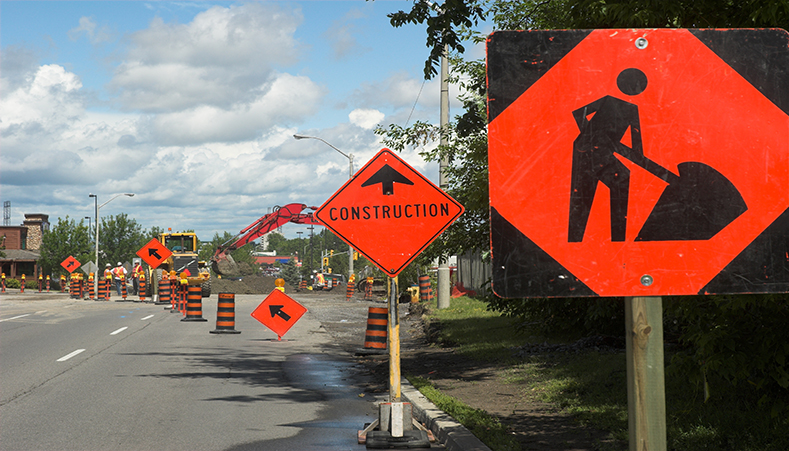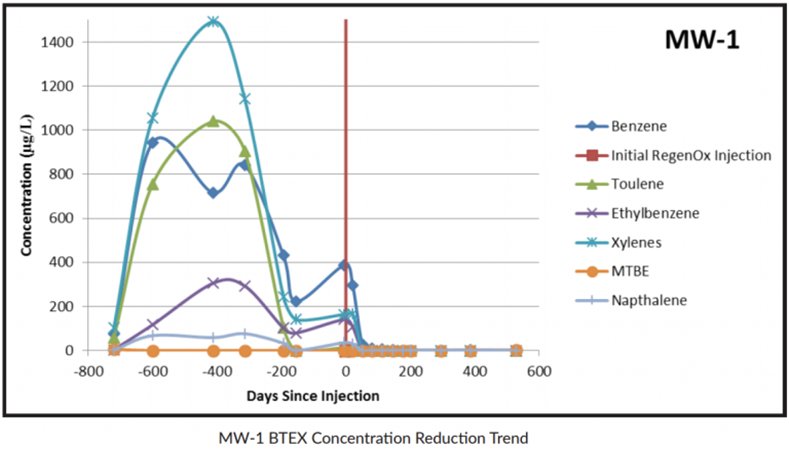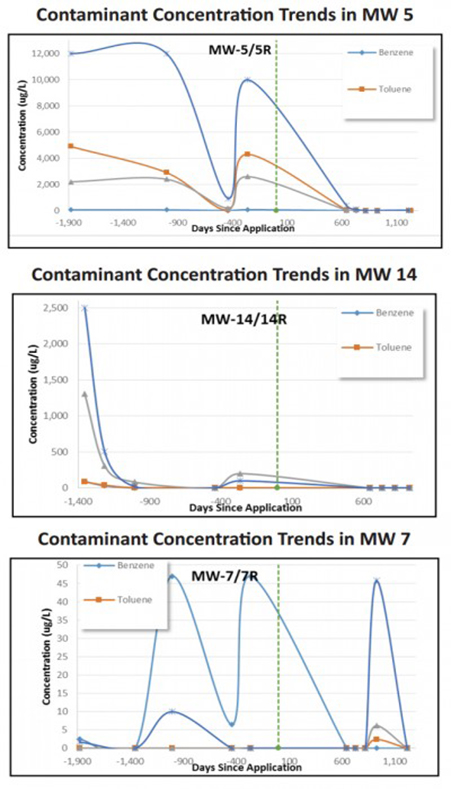Combined Remedies Treat BTEX Contamination on Government Property
Ontario, Canada Site Remediated with ORC® Advanced and RegenOx®
Project Highlights
- In Situ Chemical Oxidation (ISCO) and Enhanced Biodegradation used post-excavation to treat residual contamination.
- Extensive site mapping conducted with membrane interface probe (MIP) to detect distinct zones of higher mass contamination.
- 95% reductions seen in dissolved phase petroleum hydrocarbon contamination.
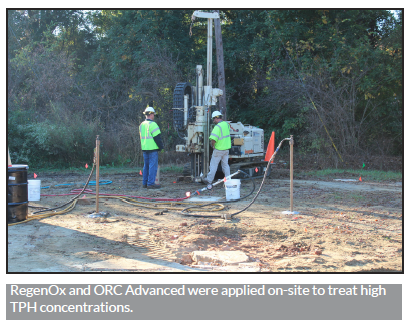
Project Summary
A large public works property in Ontario, Canada was contaminated with TPH. Approximately 5,000 gallons of fuel was released into the subsurface primarily due to fuel theft that had taken place on-site. Due to significant volumes of free-product, an excavation occurred followed by skimming activities from 2005-2010. Through extensive site evaluation, it was determined that there was a need for further mass reduction using ISCO.. RegenOx® ISCO was selected for use in the heavily and moderately impacted areas. Enhanced aerobic biodegradation using ORC® Advanced was selected for use in the dissolved-phase areas downgradient from the source. Overall, 96% reductions were seen in dissolved phase petroleum hydrocarbon concentrations.
Remediation Approach
Membrane interface probe (MIP) data was collected and proved to be integral for the remediation design and implementation. Distinct zones with high mass were present on-site and detected through the probe. RegenOx and ORC Advanced were applied via direct-push injections. Approximately 150,000 pounds of RegenOx and 45,000 pounds of ORC Advanced were applied over several injections. Higher concentrations of RegenOx were applied into the vertical zones of higher contamination to improve overall product performance.
Technology Description
Advanced Formula Oxygen Release Compound is a proprietary formulation of food-grade, calcium oxy-hydroxide that produces a controlled-release of molecular oxygen for periods of up to 12 months upon hydration.
RegenOx is an advanced chemical oxidation technology that destroys contaminants through powerful, yet controlled chemical reactions and not through biological means. This product maximizes in situ performance while using a solid alkaline oxidant that employs a sodium percarbonate complex with a multi-part catalytic formula.
PersulfOx® Treats Gasoline Tanker Truck Spill Site
Pilot Study Moved to Full-Scale Application to Remediated Benzene and TPH-G Contamination
Project Highlights
- Pilot study moves to full-scale application after large contamination concentration decrease resulting from in situ chemical oxidation (ISCO).
- High-volume, direct-injection of PersulfOx® ISCO distributes reagent beneath highway.
- ORC Advanced applied to edge of plume to prevent further migration.
- The average reductions of benzene or TPH-G were 83% and 79% respectively.
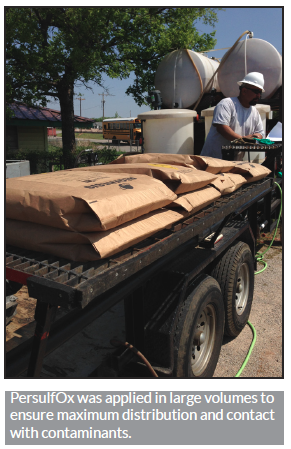
Project Summary
A gasoline tanker truck rollover occurred in Ringling, Oklahoma resulting in a benzene and TPH-G contamination. A pilot study using PersulfOx ISCO was conducted with up to 98% contamination reduction observed. Upon successful completion of the pilot study, a full-scale application was approved. A series of full-scale ISCO applications commenced to achieve significant knockdown of benzene and TPH-G concentrations at the site.
Remediation Approach
Full-scale PersulfOx injections were focused along a run-off ditch on the east side of the highway where contamination reached the groundwater during the initial spill and also downgradient on the west side of the highway where contamination had migrated.
The intent of injections on the east side of the highway were designed to address source contamination. These injections were also designed to treat the contamination beneath the highway. PersulfOx migrated through the aquifer under the influence of large direct-push injection volumes and a strong underlying groundwater gradient and natural slope of the lower confining bedrock.
Two PersulfOx injections have been completed approximately one month apart while an application of ORC Advanced also was applied in the distal part of the plume to prevent further spreading of BTEX and TPH.
The average reductions of benzene or TPH-G were 83% and 79% respectively. These are encouraging results and indicate beneficial oxidation and mass reduction of fuel hydrocarbon contamination. Ongoing monitoring will determine if additional applications are needed to reach remedial goals.
Technology Description
Advanced Formula Oxygen Release Compound (ORC Advanced®) is a proprietary formulation of food-grade, calcium oxy-hydroxide that produces a controlled-release of molecular oxygen for periods of up to 12 months upon hydration.
PersulfOx is a sodium persulfate-based chemical oxidation technology which destroys both hydrocarbon and chlorinated solvent-type contaminants in the subsurface. PersulfOx contains a built-in catalyst which activates the persulfate component and generates contaminant-destroying free radicals without the need for the addition of a separate activator.
Remediation at Multiple Service Stations using Badger Application System
RegenOx® Applied to Three Long Island Sites Contaminated with High BTEX Levels
Project Highlights
- BTEX levels higher than 20 mg/L observed on-site.
- Badger Injection System allowed for high volume applications of up to 700 gallons per injection point.
- In Situ chemical oxidation (ISCO) using 56,400 pounds of RegenOx® was used at three service station sites.
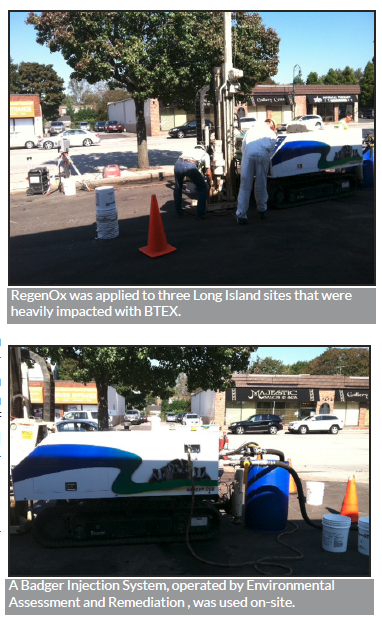
Project Summary
Several service station sites in Long Island, N.Y. were contaminated with high levels of BTEX. In heavily impacted areas, BTEX levels were higher than 20 mg/L. RegenOx was applied to the sites using the Badger Injection System, which is operated by Environmental Assessment and Remediation (EAR). The Badger injection process is used to deliver large volumes of reagent to targeted treatment zones. The objective is to obtain widespread distribution of reagent. Typical injection volumes are 500 to 700 gallons per injection point.
Remediation Approach
The Long Island sites range in size from 600-square-feet to over 4,000-square-feet.
Injection Amounts:
- Site 1 – 30,000 pounds of RegenOx; 4 Injection Events
- Site 2 – 24,000 pounds of RegenOx; 3 Injection Events
- Site 3 – 2,400 pounds of RegenOx; 2 Injection Events
Technology Description
RegenOx is an advanced chemical oxidation technology that destroys contaminants through powerful, yet controlled direct oxidation and free-radical reactions. This product maximizes in situ performance through the use of a solid alkaline oxidant (a sodium percarbonate complex) and a multi-part catalyst. These oxidation reactions do not inhibit natural bacterial populations and are compatible with biological treatment methods.
Free-Phase Hydrocarbons Significantly Reduced on Historic Spill Site Within Four Months
Project Highlights
- PetroCleanze™ applications combined with High Vacuum Dual-Phase
Extraction (HVDPE) reduced site contaminant mass and totally eliminate
free-phase hydrocarbons within four months - TPH concentrations reduced by over 97% at key monitoring well
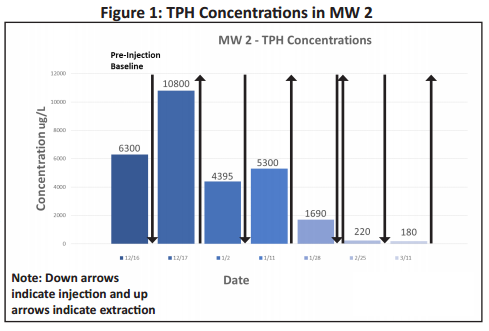
Project Summary
A leak from an above ground diesel tank caused groundwater contamination, including free-phase and dissolved hydrocarbons, and significant bound hydrocarbon mass at this manufacturing site. Remediation efforts conducted for nearly a decade included excavation, freephase hydrocarbon recovery, groundwater treatment, bio-venting, high-vacuum dual-phase extraction (HVDPE), and chemical oxidation. However, a free-phase hydrocarbon layer still existed over much of the site as indicated in key monitoring wells.
REGENESIS® recommended the use of PetroCleanze to desorb bound hydrocarbons from the plume area, which was the source of the reoccurring freephase layer. A design was developed that included a regimen of PetroCleanze injections and HVDPE events to desorb and recover the bound hydrcarbons still existing on the site, which would then be recovered by use of the existing HVDPE system.
A total of 107,000 gallons of PetroCleanze was applied through 57 injection points in a grid pattern. Four injection events occurred over the course of four months at depths of 19-27 feet below ground surface. HVDPE was conducted between injection events to recover desorbed hydrocarbon mass.
Technology Description
PetroCleanze is a customized formulation of the widely used RegenOx in situ chemical oxidation technology. The primary function of RegenOx PetroCleanze is to increase the desorption rates of hydrocarbons bound in saturated soil and make them available for more efficient and rapid treatment using a range of enhanced recovery technologies.
Results
Following treatment of the site with PetroCleanze, combined with HVDPE, groundwater hydrocarbon contamination was significantly reduced, as evidenced by a 97% reduction at key monitoring well MW-2 (See Figure 1). The consulting firm leading the project is currently performing quarterly monitoring ahead of petitioning for site closure.
Roadside Fuel Transport Spill Treated with Combined Remediation Approach
Project Highlights
- Combined remediation approach treats contaminants that remained following emergency excavation
- RegenOx® and ORC Advanced® selected to eliminate need for dedicated groundwater treatment infrastructure
- BTEX levels reduced by 97% to below non-detect levels in the two highest concentration wells
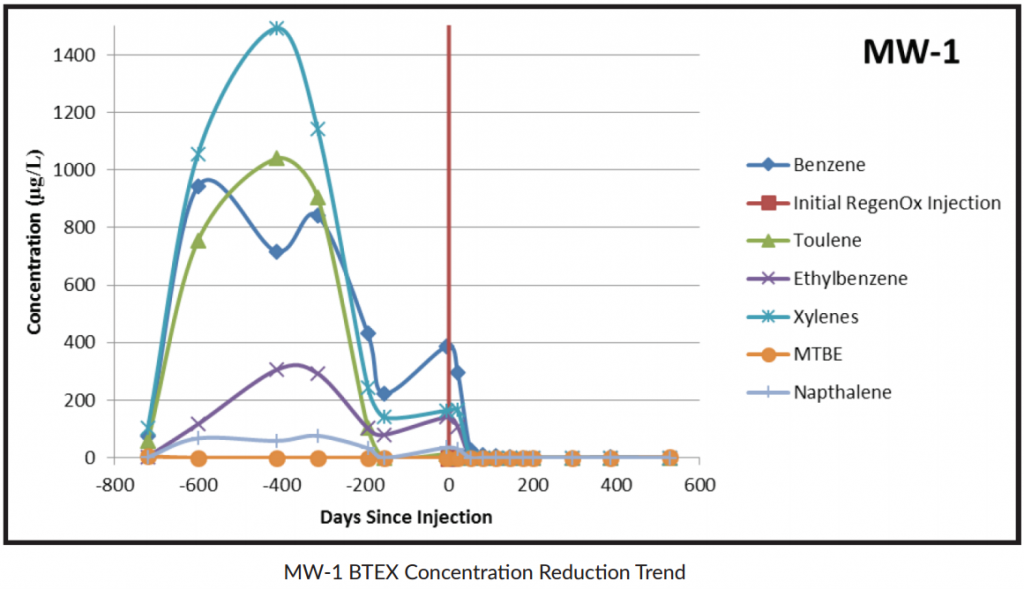
Project Summary
A rural site located in south-central North Carolina required remediation to treat petroleum contamination from an overturned tanker truck. Excavation activities during an emergency response removed much of the contaminant mass, however additional contamination in soil and groundwater remained after the excavation was completed.
In the two highest-concentration wells, total BTEX averaged more than 1,300 μg/L in the four quarterly groundwater monitoring events prior to treatment.
A combined chemical oxidation and aerobic bioremediation treatment was employed to eliminate the need for dedicated groundwater treatment infrastructure at this roadside location to advance the site to regulatory closure.
The products selected were RegenOx, an in situ chemical oxidant, and ORC Advanced, an enhanced aerobic bioremediation product. The treatment covered a 3,900-square-foot area through 30 direct-push injection points in the former spill area.
Technology Description
RegenOx is an advanced chemical oxidation technology that destroys contaminants through powerful, yet controlled chemical reactions. This product maximizes in situ performance while using a solid alkaline oxidant that employs a sodium percarbonate complex with a multi-part catalytic formula.
ORC Advanced is a proprietary formulation of food-grade, calcium oxy-hydroxide that produces a controlled-release of molecular oxygen for periods of up to 12 months upon hydration.
Results
Within 18 months of treatment, the site was under natural attenuation monitoring prior to regulatory closure with five of the six wells already below stringent regulatory requirements.
Excavation Treatment Reduces Contamination Below Clean-Up Target Levels
Project Highlights
- Remediation activities included excavating a 1,600-square-foot area contaminated with BTEX and TPH.
- ORC Advanced Pellets applied on-site to stimulate aerobic biodegradation during backfill activities.
- Two monitoring wells reduced to below groundwater contaminant targets.
Project Summary
The Bryant Grocery and Saw Co. site in the Florida Panhandle was the subject of excavation activities to remediate significant BTEX and TPH contamination as a result of historical releases from gasoline underground storage tanks (USTs). Excavation activities were planned for an area of approximately 1,600-square-feet to a depth of 14 feet below ground surface.
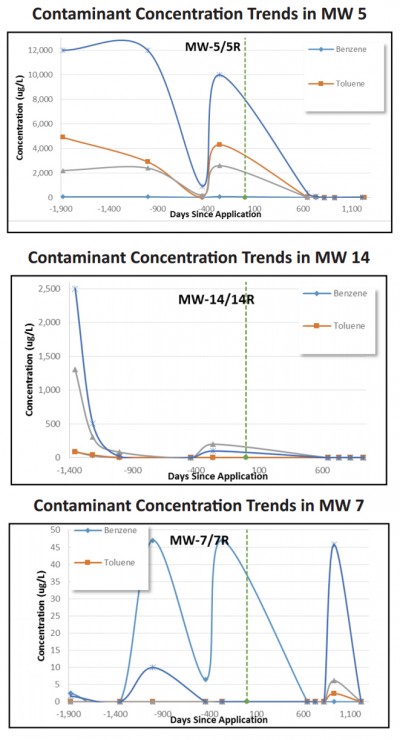
Remediation Approach
During backfill activities, ORC Advanced Pellets were added to provide a long-term source of oxygen to promote aerobic biodegradation of residual, dissolved-phase petroleum constituents remaining in the excavation area. A total of 520 pounds of ORC Advanced Pellets were applied to the saturated zone of the excavation. Both MW-7R and MW-14R have seen BTEX, TRPH, and MTBE reduced to stringent groundwater quality standards for Florida (Groundwater Contaminant Target Levels, or GCTLs). In MW-5R, Total Residual Petroleum Hydrocarbons (TRPH), MTBE, benzene, and ethylbenzene have been reduced to below GCTLs. Toluene and xylenes concentrations remain slightly above GCTLs but have declined by more than 99% related to both constituents.
Technology Description
Advanced Formula Oxygen Release Compound (ORC Advanced®) is a proprietary formulation of food-grade, calcium oxy-hydroxide that produces a controlled-release of molecular oxygen for periods of up to 12 months upon hydration
Single PersulfOx® Treatment Reduces MTBE Concentrations by 50 Percent
Project Highlights
- Both PersulfOx and NaOH activated persulfate used on-site to test effectiveness
- Single injection event of PersulfOx resulted in 50% reduction of MTBE
- Backfilled gravel excavation used as a treatment cell for contaminant mass migrating from an inaccessible dispenser canopy toward the property boundary
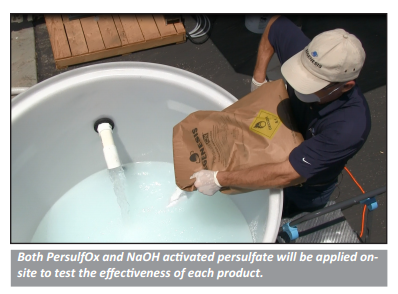
Project Summary
A gas station in the Washington DC metro area was contaminated with BTEX and MTBE following a release from a dispenser island. High concentrations of MTBE (160 ppm) diffused into the native silty clay and beyond the property boundary. Two persulfate chemistries utilized at the site to evaluate treatment longevity. Persulfate test kits demonstrated that PersulfOx remained active for six months. The PersulfOx® injections were performed within a downgradient former excavation which was backfilled with gravel to intercept the contaminants. The single injection event of PersulfOx resulted in 50% reduction of MTBE. Treatments in the former excavation have also reduced MTBE concentrations at the property boundary.
Remediation Approach
The PersulfOx injection was performed into three injection wells that were located in an excavation that was backfilled with gravel. This gravel backfilled excavation used as a treatment cell for contaminants originating from under the dispenser canopy (upgradient). The goal was to oxidize contaminant mass as it moves through the former excavation toward the property boundary. The native soils consisted of silty clay, which have a low hydraulic conductivity and do not accept injection volumes easily. This approach treats the petroleum bleed-off from the dispenser canopy before it moves downgradient and eventually off-site. The purpose of the project was designed to evaluate performance data where PersulfOx and NaOH activated persulfate were compared for contaminant reduction trends, longevity, and ease of application.
Technology Description
PersulfOx is a sodium persulfate-based chemical oxidation technology which destroys both hydrocarbon and chlorinated solventtype contaminants in the subsurface. PersulfOx contains a built-in catalyst which activates the persulfate component and generates contaminant-destroying free radicals without the need for the addition of a separate activator.
Residential Property Treated for TPHd Concentrations in Groundwater
Project Highlights
- Excavation and remediation injections performed in a tight residential setting with intense local community involvement.
- Treatment included shoring/excavation, soil handling and off-site disposal, in situ chemical oxidation (ISCO), bioremediation and sewer replacement.
- Groundwater sampling post-remediation indicates an overall decrease in TPHd concentrations and monitoring is ongoing.
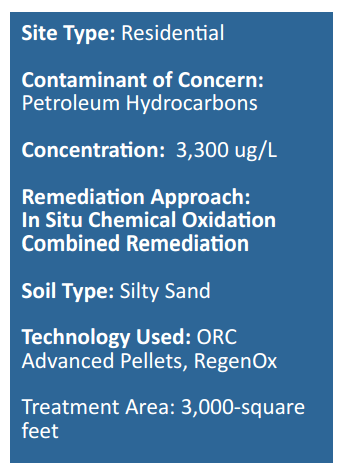
Project Summary
An underground heating oil storage tank contaminated the groundwater below a residential property in Northern California. The two-story home, located near a downtown beach community, had a 100-gallon heating oil tank that was removed in 1994. Site investigation and groundwater monitoring activities were conducted since the removal, when apparent petroleum hydrocarbon impacts were identified. TPHd concentrations of 3,300 ug/L were detected on-site.
Remediation proved to be difficult considering the location of the residential property. The home was surrounded by other residences on three of its corners, with a bed and breakfast and swimming school located to the northwest of the property. A tight injection approach was required so the neighboring properties were not disturbed.
Remediation Approach
To meet the objective mass reduction of residual TPHd in both soil and groundwater, the remedial approach combined excavation/shoring and removal of TPHd impacted soils. It also included ISCO using RegenOx® and bioremediation using Oxygen Release Compound (ORC Advanced®). Approximately 233 cubic yards of soil were removed. A total of 2,350 pounds of RegenOx Part A and 1,320 pounds of Regenox Part B, along with 716 pounds of ORC Advanced® in slurry form, was injected into the subsurface via 16 direct-push injections.
Technology Description
ORC Advanced is a proprietary formulation of food-grade, calcium oxy-hydroxide that produces a controlled-release of molecular oxygen for periods of up to 12 months upon hydration.
RegenOx is an advanced chemical oxidation technology that destroys contaminants through powerful, yet controlled chemical reactions and not through biological means. This product maximizes in situ performance while using a solid alkaline oxidant that employs a sodium percarbonate complex with a multi-part catalytic formula.
ORC® Advanced Pellets Utilized as Part of Combined Remedy Approach at Ohio Brownfield’s Project
Project Highlights
- Ohio VAP Certified Professional specified ORC® Advanced Pellets in Remedial Action Plan for purpose of obtaining grant through the Clean Ohio Revitalization Fund (CORF).
- $1.98 million in brownfield’s funding was granted through CORF as a result of Proposed Remedial Action Plan.
- Approximately 18,000 pounds of ORC® Advanced Pellets were applied to the base of 5 former underground storage tank excavation sites to address residual TPH and PAH impacts in groundwater
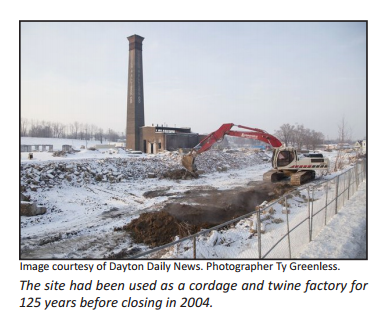
Project Summary
The site, a former cordage and twine factory in Ohio, was closed in 2004 after 125 years of operation. The city and developer secured $1.98 million in brownfield’s funding through the Clean Ohio Revitalization Fund (CORF). These funds were secured for demolition and remediation activities at the site included but not limited to asbestos removal, underground storage tank removal, and contaminated soil excavation and demolition activities.
Remediation Approach
Approximately 18,000 pounds of ORC Advanced Pellets were specified by the Ohio VAP Certified Professional responsible for this project. Per the CORF remedial plan the pellets were applied to the base of 5 former underground storage tankexcavation sites. As part of this combined remedy approach (excavation + biodegradation), ORC Advanced Pellets were included to promote enhanced aerobic biodegradation of residual TPH and PAH impacts in water for a period of 9-12 months.
Technology Description
ORC Advanced® Pellets (ORC-A Pellets) are a pelletized version of REGENESIS’ widely-used ORC Advanced and are designed specifically for direct application into excavations, tank pits and trenches. This pelletized, dry application material minimizes airborne dust while eliminating the need for specialized equipment and spray water required for powder-slurry applications. ORC Advanced Pellets are approximately 3-10 mm in size.
Combined Technologies Treat High TBA Levels
Site Closure Pending at Active California Retail Petroleum Service Station
Project Highlights
- A range of various remediation approaches were applied at the site over a span of 20 years.
- Enhanced Aerobic Biodegradation (EAB) remediation approach replaces soil excavation plan at site.
- Site closure pending.
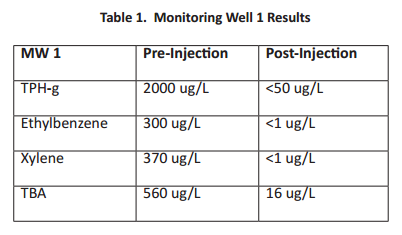
Project Summary
An active service station in Southern California was contaminated with high levels of TBA and TPH-g. Various active remediation approaches took place on-site for nearly 20 years including excavation of the underground storage tanks and dispensers, soil vapor extraction and groundwater pump and treat. Although the active remediation reduced concentrations at the source, contamination levels remained high. Regenesis became involved with the site in 2011 and after two applications of enhanced aerobic biodegradation using ORC® Advanced and RegenOx®, site closure is pending.
Remediation Approach
In 1995, the underground storage tanks and dispensers were excavated and 257 tons of contaminated soil was removed. From 2003 to 2009, dissolved oxygen injection was applied into seven injection wells and in 2009, over 6,000 gallons of water was extracted from one well. In November 2011, Regenesis became involved in the project and proposed a combined remedies approach.
The remedy implemented at the site from November 2011 through November 2012 included introduction of a controlledrelease molecular oxygen into the subsurface water to promote bio-degradation of the fuel hydrocarbons. The implementation of the remedy was completed in two phases with the initial injection activities being completed in November 2011. A second injection event was completed at the site in November 2012. Approximately a total of 6,000 pounds of ORC Advanced and 480 pounds of RegeneOx were applied on-site.
Contaminant concentrations were analyzed in the most recent monitoring events and compared to pre-injection concentrations. Results for performance monitoring well MW 1 were the most significant as all contaminant concentrations decreased to below regulatory limits (Table 1). Closure has been requested and is currently pending.
Technology Description
Advanced Formula Oxygen Release Compound (ORC Advanced®) is a proprietary formulation of food-grade, calcium oxyhydroxide that produces a controlled-release of molecular oxygen for periods of up to 12 months upon hydration.
RegenOx is an advanced chemical oxidation technology that destroys contaminants through powerful, yet controlled chemical reactions and not through biological means. This product maximizes in situ performance while using a solid alkaline oxidant that employs a sodium percarbonate complex with a multi-part catalytic formula.

 Americas
Americas Europe
Europe Français
Français Deutsch
Deutsch Italiano
Italiano Español
Español